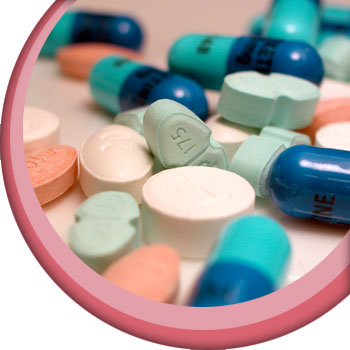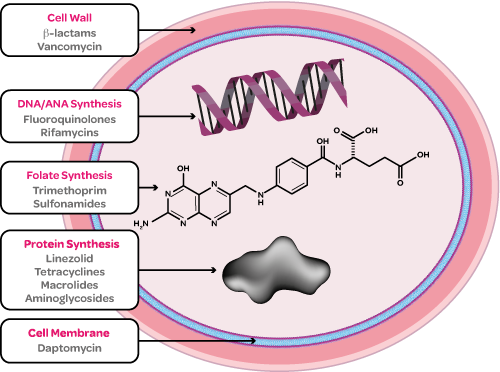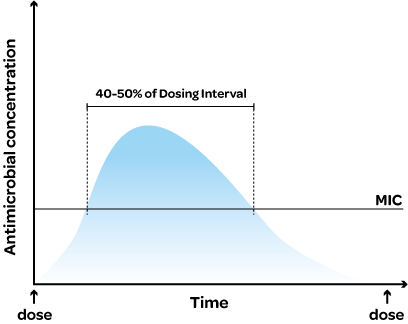Choosing an Antimicrobial
An important component of rational use of antimicrobials is the selection of an
appropriate drug for the clinical situation. There are several things to consider
when choosing an antimicrobial, such as the mechanism of action of the
antimicrobial and the type of bacteria present.

Mechanism of action of antimicrobials
Understanding the mechanism of action of antimicrobials may aid in predicting likely efficacy against target bacteria and presence of resistance. It may also assist when deciding which antimicrobials to use in combination therapy. There are four major mechanisms of action of antimicrobial drugs:

Inhibition of cell wall synthesis
Beta-lactam antimicrobials bind to the bacterium at penicillin binding proteins and inhibit cross linking of the peptide chains.21 They also inactivate an inhibitor of autolytic enzymes causing lysis of the bacterium.4 This class of antimicrobial includes the penicillins, cephalopsorins, carbapenems and monobactams.
Vancomycin and bacitracin also interfere with cell wall synthesis,4 but are not commonly used in veterinary medicine.
Inhibition of protein synthesis
Bacterial protein synthesis takes place in the ribosomes which consist of a 30S and a 50S subunit (different to mammalian ribosomes). Other important components are mRNA which forms a template for protein synthesis, and tRNA which delivers amino acids.
• Tetracyclines, such as oxytetracycline and doxycycline, are taken into bacterial cells by active transport4 and then prevent access of tRNA to the ribosome.21
• Chloramphenicol binds to the 50S subunit and inhibits transpeptidation.4
• Aminoglycosides, such as gentamicin, streptomycin and amikacin, cross the cell membrane by oxygen-dependent active transport and therefore have minimum activity against anaerobes.4 They bind to the same site as chloramphenicol and cause misreading of mRNA.21
• Macrolides, such as erythromycin and clarithromycin, bind to the 50S subunit at the same site as chloramphenicol4 and inhibit translocation of the peptide chain.21
• Lincosamides, such as lincomycin and clindamycin, also bind to the same site on the 50S subunit and have similar action to the macrolides.4
Inhibition of nucleic acid synthesis
• Sulphonamides interfere with folate synthesis. Folate is required for DNA synthesis, and is synthesised in bacteria. Sulphonamides compete with PABA, the precursor to folate, for enzyme binding sites and therefore inhibit the metabolism.4 This explains why they are bacteriostatic rather than bactericidal.
• Trimethoprim interferes with the conversion of folate to tetrahydrofolate by acting as a folate antagonist at enzyme binding sites.4 The use of trimethoprim and sulphonamides together forms a sequential blockade to the metabolic pathway often making them more successful than they would be alone.4
• Fluoroquinolones, such as marbofloxacin, inhibit DNA gyrase (topoisomerase II) and topoisomerase IV,21 which would normally produce the negative supercoiling of DNA. This then prevents transcription or replication of the DNA.4
Disruption of cell membrane function
Polymixins have cationic detergent properties and interact with the phosholipid of the cell membrane to disrupt its structure.4 This causes death of Gram-negative bacteria.
Type of bacteria present
Knowledge of the bacterial species present when dealing with an infectious condition will be very helpful in selecting an appropriate antimicrobial and therefore culture and sensitivity testing is often indicated. If this information is not available, for example if treatment needs to be started whilst awaiting culture and sensitivity results, a combination of cytology and a knowledge of which pathogens are likely for a given situation may help in selecting an appropriate antimicrobial.
• Two key features to look for on cytology are whether the bacteria are Gram-positive or Gram-negative, and whether they are rods or cocci.
• Knowledge of the site of infection may suggest whether bacteria are likely to be aerobic or anaerobic, for example cases of pyothorax and abscesses are likely to involve obligate and facultative anaerobes.3
• Some sites have predictable common bacterial species, for example Staphylococci in canine pyoderma.3
Pharmacokinetic and Pharmacodynamic characteristics (PK/PD)
Pharmacokinetics (how the body affects a drug)4 and pharmacodynamics (the effects of a drug within the body)4 are both important in influencing dosage regimens for antimicrobial agents and therefore need to be integrated to allow optimal dosing.22
In order to study the PK/PD relationship, antimicrobials can be divided into three categories – bacteriostatic, bactericidal that exhibit time-dependent killing and bactericidal that exhibit concentration-dependent killing.
Bacteriostatic - Inhibition of Nucleic Acid Synthesis
These antimicrobials inhibit the growth of bacteria rather than killing them,4 an effect which is reversible once the drug is removed.3 The concentration at the site of infection must be higher than the minimum inhibitory concentration (MIC) of the strain of bacteria throughout the dosing interval.3
Bacteriostatic antimicrobials include tetracyclines, macrolides, clindamycin, chloramphenicol and sulphonamides,3,4,6 although macrolides and clindamycin may be bactericidal at high concentrations against certain organisms.4,6
Bactericidal – Time-Dependent Killing
 For these drugs the duration of exposure of the bacteria to the antimicrobial is the most important factor. The major PK/PD parameter indicative of efficacy is the time for which the serum concentration exceeds the MIC (T>MIC). The required time above MIC varies for different pathogens, infection sites and drugs but is mostly 40-50% of the dosing interval.22
For these drugs the duration of exposure of the bacteria to the antimicrobial is the most important factor. The major PK/PD parameter indicative of efficacy is the time for which the serum concentration exceeds the MIC (T>MIC). The required time above MIC varies for different pathogens, infection sites and drugs but is mostly 40-50% of the dosing interval.22
Time-dependent antimicrobials include penicillins and cephalosporins.3
Bactericidal – Concentration-Dependent Killing
 For these drugs the higher the peak plasma concentration, the greater the proportion of bacteria killed.3 These drugs often also have a prolonged post antibiotic effect (PAE) – the persistent suppression of bacterial growth following the removal of the antibiotic from the locus of bacteria.23 The major parameters that correlate with efficacy are the 24 hour area under serum drug concentration curve (AUC) to MIC ratio, or the peak plasma concentration (Cmax) to MIC ratio.22 These are based on free or unbound drug concentrations. The value of these parameters needed for efficacy can again vary depending on the drug and pathogen, but guideline values given are AUC:MIC ≥ 25-30 and Cmax:MIC ≥ 10-12.22
For these drugs the higher the peak plasma concentration, the greater the proportion of bacteria killed.3 These drugs often also have a prolonged post antibiotic effect (PAE) – the persistent suppression of bacterial growth following the removal of the antibiotic from the locus of bacteria.23 The major parameters that correlate with efficacy are the 24 hour area under serum drug concentration curve (AUC) to MIC ratio, or the peak plasma concentration (Cmax) to MIC ratio.22 These are based on free or unbound drug concentrations. The value of these parameters needed for efficacy can again vary depending on the drug and pathogen, but guideline values given are AUC:MIC ≥ 25-30 and Cmax:MIC ≥ 10-12.22
Concentration-dependent antimicrobials include aminoglycosides and fluoroquinolones.3
Pharmacokinetic parameters – considerations
Plasma concentration of antimicrobial (unbound) is usually the best predictor of clinical success as this is usually equivalent to tissue concentration but there are some exceptions to this including where a barrier exists e.g.in the central nervous system (CNS) or an abscess, and where bacteria are intracellular.23 Areas of the body where drug diffusion is permeability limited due to the lipid membrane include:3
- CNS (although inflammation may increase permeability)
- Eye
- Epithelial lining of the lung
- Prostate
- Mammary gland
It is therefore important to consider the physicochemical properties of antimicrobial agents when selecting a drug to treat an infection in one of these areas. Hydrophilic drugs do not readily penetrate cellular barriers such as the blood-brain barrier. These include penicillins, cephalosporins, aminoglycosides and polymixins.3 Drugs of moderate lipophilicity cross cellular membranes more readily. These include trimethoprim, sulphonamides, lincosamides and macrolides and oxytetracycline.3 Highly lipophilic molecules may reach all fluid compartments and enter cells. They include chloramphenicol, fluoroquinolones, doxycycline and metronidazole.3
Pharmacodynamic parameters – considerations
The MIC is the lowest concentration of antimicrobial which inhibits the growth of the target bacteria.23 This is an in vitro parameter, and therefore factors present in vivo may cause discrepancy between in vitro results and the true figure. These include pH, presence or absence of oxygen, specific anatomical or physiological situations e.g. urinary tract, and specific pathological situations e.g. abscessation, or presence of pus or oedema fluid.3,23 Wound cleansing and lavage or surgical drainage can be vital to improve antimicrobial efficacy in these pathological situations.3
Knowledge of likely resistance
It is useful to be aware of any likely resistance in the target bacteria as this may influence the choice of antimicrobial. Although this can be achieved through reference to current trends reported, it is worth noting that these trends may vary between countries,8 and it is also suggested that veterinary surgeons should have an awareness of resistance trends in their own practice for specific conditions or pathogens.16 This can be achieved if culture and sensitivity is being performed for a representative number of cases of a particular condition.
Likely adverse effects
Specific patient factors may determine suitability of certain products, for example use of concurrent medication, age or breed. Individual datasheets for products should be consulted for potential contraindications.
Consideration of critically important antimicrobials
Consideration should be given to trying to minimise the use of those antimicrobials considered critically important for human medicine if there is an alternative option. For example it may be best to save these drugs for second line treatment or for cases where culture and sensitivity testing indicate their use. The antimicrobials that are considered critically important for human medicine are:
- Fluoroquinolones.
- 3rd and 4th generation cephalosporins.
- Macrolides.
- Glycopeptides.
Disclaimer: Indications and doses may vary between products. The antimicrobials listed may constitute an off licence use of the product and as such should only be used according to the ‘Cascade’, further details of which are available on the RCVS, VMD and NOAH websites. Veterinary surgeons are advised to carefully check the Summary of Product Characteristics (SPC) before prescribing a product and obtain informed owner consent where required.

